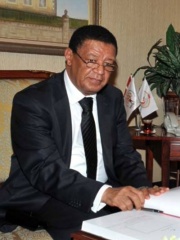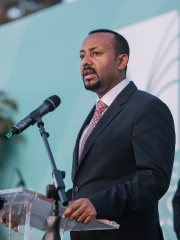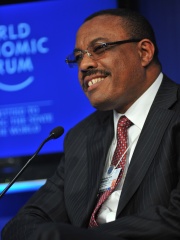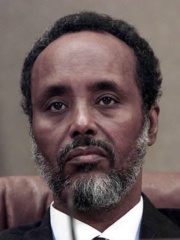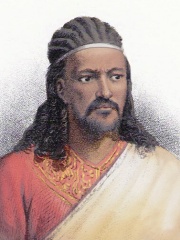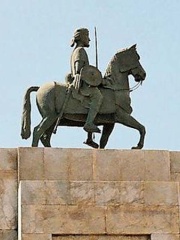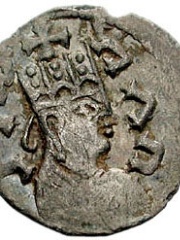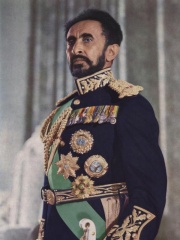
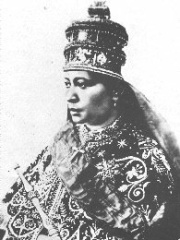
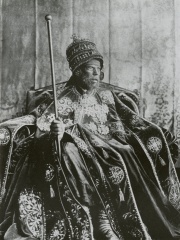
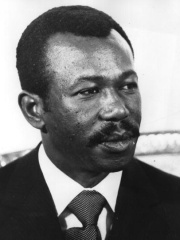
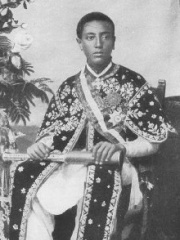
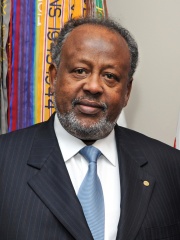

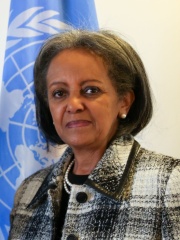
The Most Famous
POLITICIANS from Ethiopia
This page contains a list of the greatest Ethiopian Politicians. The pantheon dataset contains 19,576 Politicians, 27 of which were born in Ethiopia. This makes Ethiopia the birth place of the 86th most number of Politicians behind Malaysia, and Cambodia.
Top 10
The following people are considered by Pantheon to be the top 10 most legendary Ethiopian Politicians of all time. This list of famous Ethiopian Politicians is sorted by HPI (Historical Popularity Index), a metric that aggregates information on a biography’s online popularity. Visit the rankings page to view the entire list of Ethiopian Politicians.

1. Haile Selassie (1892 - 1975)
With an HPI of 71.15, Haile Selassie is the most famous Ethiopian Politician. His biography has been translated into 98 different languages on wikipedia.
Haile Selassie I (Ge'ez: ቀዳማዊ ኀይለ ሥላሴ, romanized: Qädamawi Haylä Səllasé, lit. 'Power of the Trinity'; born Tafari Makonnen; 23 July 1892 – 27 August 1975) was the Emperor of Ethiopia from 1930 to 1974. He rose to power as Regent Plenipotentiary of Ethiopia (Enderase) for Empress Zewditu from 1916 until 1930. Haile Selassie is widely considered a defining figure in modern Ethiopian history, and the major figure of Rastafari, a religious movement in Jamaica that emerged shortly after he became emperor in the 1930s. Before he rose to power he defeated Ras Gugsa Welle Bitul (nephew of Empress Taytu) of Begemder at the Battle of Anchem in 1928. He was a member of the Solomonic dynasty, which claims to trace lineage to Emperor Menelik I, a legendary figure believed by the claimants to be the son of King Solomon and the Queen of Sheba, who they name as Makeda. Haile Selassie attempted to modernise the country through a series of political and social reforms, including the introduction of the 1931 constitution, its first written constitution, and the abolition of slavery. He led the failed efforts to defend Ethiopia during the Second Italo-Ethiopian War and spent most of the period of Italian occupation exiled in the United Kingdom. In 1940, he travelled to the Anglo-Egyptian Sudan to assist in coordinating the anti-fascist struggle in Ethiopia and returned to his home country in 1941 after the East African campaign. He dissolved the Federation of Ethiopia and Eritrea, which was established by the UN General Assembly in 1950, and annexed Eritrea into Ethiopia as one of its provinces, while fighting to prevent secession.Haile Selassie's internationalist views led to Ethiopia becoming a charter member of the United Nations. In 1963, he presided over the formation of the Organisation of African Unity, the precursor of the African Union, and served as its first chairman. In 1974, he was overthrown in a military coup by a Marxist–Leninist junta, the Derg. On 27 August 1975, Haile Selassie was assassinated by Derg military officers, a fact that was only revealed in 1994.Among some members of the Rastafari movement, Haile Selassie is referred to as the returned messiah of the Bible, God incarnate. This distinction notwithstanding, he was a Christian and adhered to the tenets and liturgy of the Ethiopian Orthodox Church. He has been criticised by some historians for his suppression of rebellions among the landed aristocracy (the mesafint), which consistently opposed his changes. Some critics have also criticised Ethiopia's failure to modernise rapidly enough. During his rule the Harari people were persecuted and many left the Harari Region. His administration was also criticised by human rights groups, such as Human Rights Watch, as autocratic and illiberal. Although some sources state that late during his administration the Oromo language was banned from education, public speaking and use in administration, there was never an official law or government policy that criminalised any language. The Haile Selassie government relocated numerous Amharas into southern Ethiopia where they served in government administration, courts, and church. Following the death of Hachalu Hundessa in June 2020, the Statue of Haile Selassie in Cannizaro Park, London was destroyed by Oromo protesters, and his father's equestrian monument in Harar was removed.

2. Zewditu (1876 - 1930)
With an HPI of 71.05, Zewditu is the 2nd most famous Ethiopian Politician. Her biography has been translated into 45 different languages.
Zewditu (Ge'ez: ዘውዲቱ, born Askala Maryam; 29 April 1876 – 2 April 1930) was Empress of Ethiopia from 1916 until her death in 1930. The first female head of an internationally recognized country in Africa in the 19th and 20th centuries, and the first and only empress regnant of the Ethiopian Empire, her reign was noted for the reforms of her Regent and designated heir Ras Tafari Makonnen (who succeeded her as Emperor Haile Selassie I), about which she was at best ambivalent and often stridently opposed, due to her staunch conservatism and strong religious devotion. She is the most recent empress regnant, as well as the last female Ethiopian head of state until the 2018 election of Sahle-Work Zewde as president.

3. Menelik II (1844 - 1913)
With an HPI of 66.93, Menelik II is the 3rd most famous Ethiopian Politician. His biography has been translated into 50 different languages.
Menelik II (Ge'ez: ዳግማዊ ምኒልክ dagmawi mənilək; horse name Abba Dagnew (Amharic: አባ ዳኘው abba daññäw); 17 August 1844 – 12 December 1913), baptised as Sahle Maryam (ሣህለ ማርያም sahlä maryam) was king of Shewa from 1866 to 1889 and Emperor of Ethiopia from 1889 to his death in 1913. At the height of his internal power and external prestige, the process of territorial expansion and creation of the modern empire-state was completed by 1898.The Ethiopian Empire was transformed under Emperor Menelik: the major signposts of modernisation were put in place, with the assistance of key ministerial advisors. Externally, Menelik led Ethiopian troops against Italian invaders in the First Italo-Ethiopian War; following a decisive victory at the Battle of Adwa, recognition of Ethiopia's independence by external powers was expressed in terms of diplomatic representation at his court and delineation of Ethiopia's boundaries with the adjacent kingdoms. Menelik expanded his realm to the south and east, into Oromo, Kaffa, Sidama, Wolayta and other kingdoms or peoples.: 2 Later in his reign, Menelik established the first Cabinet of Ministers to help in the administration of the Empire, appointing trusted and widely respected nobles and retainers to the first Ministries. These ministers would remain in place long after his death, serving in their posts through the brief reign of Lij Iyasu (whom they helped depose) and into the reign of Empress Zewditu.

4. Mengistu Haile Mariam (b. 1937)
With an HPI of 66.81, Mengistu Haile Mariam is the 4th most famous Ethiopian Politician. His biography has been translated into 62 different languages.
Mengistu Haile Mariam (Amharic: መንግሥቱ ኀይለ ማርያም, pronunciation: [mənɡɨstu haɪlə marjam]; born 21 May 1937) is an Ethiopian former politician and former army officer who was the head of state of Ethiopia from 1977 to 1991 and General Secretary of the Workers' Party of Ethiopia from 1984 to 1991. He was the chairman of the Derg, the socialist military junta that governed Ethiopia, from 1977 to 1987, and the president of the People's Democratic Republic of Ethiopia (PDRE) from 1987 to 1991.The Derg took power in the Ethiopian Revolution following the overthrow of Emperor Haile Selassie I in 1974, marking the end of the Solomonic dynasty which had ruled Ethiopia since the 13th century. Mengistu purged rivals for power from the Derg and made himself dictator of Ethiopia, attempting to modernize the feudal economy of Ethiopia through Marxist-Leninist-inspired policies such as nationalization and land redistribution. His bloody consolidation of power in 1977–1978 is known as the Ethiopian Red Terror, a brutal crackdown on opposition groups and civilians following a failed assassination attempt by the Ethiopian People's Revolutionary Party (EPRP) in September 1976, after it had ignored the Derg's invitation to join the union of socialist parties. The death toll is unknown but is often estimated at between 30,000 and 750,000. Internal rebellion, government repression, and economic mismanagement characterized Mengistu's presidency, the Red Terror period being a battle for dominance between the Derg, the EPRP, and their rival the All-Ethiopia Socialist Movement (MEISON), which had initially aligned itself with the Derg. While this internal conflict was being fought, Ethiopia was threatened by both the Somali invasion and the guerrilla campaign of the Eritrean People's Liberation Front, who demanded independence for Eritrea, then a province of Ethiopia. The Ogaden War of 1977–1978 with Somalia, fought over a disputed border region (Ogaden), was notable for the prominent role of Mengistu's Soviet and Cuban allies in securing an Ethiopian victory. The catastrophic famine of 1983–1985 is what brought his government the most international attention. Mengistu fled to Zimbabwe in May 1991 after the PDRE National Shengo dissolved itself and called for a transitional government. His departure brought an abrupt end to the Ethiopian Civil War. Mengistu Haile Mariam still lives in Harare, Zimbabwe, despite an Ethiopian court verdict which found him guilty of genocide in absentia. Mengistu's government is estimated to be responsible for the deaths of 500,000 to 2,000,000 Ethiopians, mostly during the 1983–1985 famine in Ethiopia.
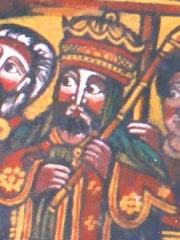
5. Menelik I (-954 - -930)
With an HPI of 66.17, Menelik I is the 5th most famous Ethiopian Politician. His biography has been translated into 27 different languages.
Menelik I (Ge'ez: ምኒልክ, Mənilək) was the legendary first Emperor of Ethiopia. According to Kebra Nagast, a 14th-century national epic, in the 10th century BC he is said to have inaugurated the Solomonic dynasty of Ethiopia, so named because Menelik I was the son of the biblical King Solomon of ancient Israel and of Makeda, the Queen of Sheba.

6. Lij Iyasu of Ethiopia (1895 - 1935)
With an HPI of 64.36, Lij Iyasu of Ethiopia is the 6th most famous Ethiopian Politician. His biography has been translated into 26 different languages.
Lij Iyasu (Ge'ez: ልጅ ኢያሱ; 4 February 1895 – 25 November 1935) was the designated Emperor of Ethiopia from 1913 to 1916. His baptismal name was Kifle Yaqob (ክፍለ ያዕቆብ kəflä y’aqob). Ethiopian emperors traditionally chose their regnal name on the day they were crowned, and since he was never crowned, he is usually referred to as Lij Iyasu, "Lij" meaning child, especially one born of royal blood.

7. Ismaïl Omar Guelleh (b. 1946)
With an HPI of 63.39, Ismaïl Omar Guelleh is the 7th most famous Ethiopian Politician. His biography has been translated into 56 different languages.
Ismaïl Omar Guellé (Somali: Ismaaciil Cumar Geelle; Arabic: إسماعيل عمر جيله) (born 27 November 1946) is a Djiboutian politician who has served as the President of Djibouti since 1999, making him one of the longest-serving rulers in Africa. He is often referred to by his initials, IOG. Guelleh was first elected as President in 1999 as the handpicked successor to his uncle, Hassan Gouled Aptidon, who had ruled Djibouti since independence in 1977. Guelleh was re-elected in 2005, 2011, 2016 and in 2021. The elections were largely boycotted by the opposition amid complaints over widespread irregularities. Guelleh has been characterized as a dictator, and his rule has been criticized by human rights groups and governments, such as the United States. He is, at the international level, a close ally of France. He was awarded the Padma Vibhushan, India's second-highest civilian award, on 25 January 2019 for his role in the safe evacuation of Indian citizens from Yemen.

8. Gebre Mesqel Lalibela (1200 - 1221)
With an HPI of 62.07, Gebre Mesqel Lalibela is the 8th most famous Ethiopian Politician. His biography has been translated into 24 different languages.
Lalibela (Ge'ez: ላሊበላ), regnal name Gebre Meskel (Ge'ez: ገብረ መስቀል gäbrä mäsqäl, "Servant of the Cross"), was a king of the Zagwe dynasty, reigning from 1181 to 1221.: 22 : 56n He was the son of Jan Seyum and the brother of Kedus Harbe. Perhaps the best-known Zagwe monarch, he is credited as the patron of the namesake monolithic rock-hewn churches of Lalibela. He is venerated as a saint by the Ethiopian Orthodox Tewahedo Church on 19 June.

9. Sahle-Work Zewde (b. 1950)
With an HPI of 60.30, Sahle-Work Zewde is the 9th most famous Ethiopian Politician. Her biography has been translated into 66 different languages.
Sahle-Work Zewde (Amharic: ሣህለ ወርቅ ዘውዴ, born 21 February 1950) is an Ethiopian politician and diplomat who is the president of Ethiopia since 2018, being the first woman to hold the office. She was elected as president unanimously by members of the Federal Parliamentary Assembly on 25 October 2018.American business magazine Forbes, on its annual edition of the Forbes list of The World's 100 Most Powerful Women, listed Sahle-Work as the 96th most powerful woman in the world, and the highest-ranking African woman on the list.
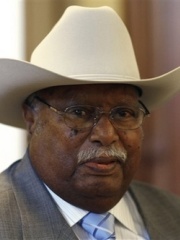
10. Girma Wolde-Giorgis (1924 - 2018)
With an HPI of 58.95, Girma Wolde-Giorgis is the 10th most famous Ethiopian Politician. His biography has been translated into 49 different languages.
Girma Wolde-Giorgis (Amharic: ግርማ ወልደ ጊዮርጊስ; 28 December 1924 – 15 December 2018) was an Ethiopian politician who was the president of Ethiopia from 2001 to 2013. He was the second person to hold the office of president since the founding of the Federal Democratic Republic of Ethiopia in 1995.
People
Pantheon has 32 people classified as Ethiopian politicians born between 954 BC and 1976. Of these 32, 8 (25.00%) of them are still alive today. The most famous living Ethiopian politicians include Mengistu Haile Mariam, Ismaïl Omar Guelleh, and Sahle-Work Zewde. The most famous deceased Ethiopian politicians include Haile Selassie, Zewditu, and Menelik II. As of April 2024, 1 new Ethiopian politicians have been added to Pantheon including Sahle Dengel.
Living Ethiopian Politicians
Go to all RankingsMengistu Haile Mariam
1937 - Present
HPI: 66.81
Ismaïl Omar Guelleh
1946 - Present
HPI: 63.39
Sahle-Work Zewde
1950 - Present
HPI: 60.30
Mulatu Teshome
1955 - Present
HPI: 55.41
Abiy Ahmed
1976 - Present
HPI: 54.82
Hailemariam Desalegn
1965 - Present
HPI: 48.29
Abdiqasim Salad
1941 - Present
HPI: 46.14
Zera Yacob Amha Selassie
1953 - Present
HPI: 43.54
Deceased Ethiopian Politicians
Go to all RankingsHaile Selassie
1892 - 1975
HPI: 71.15
Zewditu
1876 - 1930
HPI: 71.05
Menelik II
1844 - 1913
HPI: 66.93
Menelik I
954 BC - 930 BC
HPI: 66.17
Lij Iyasu of Ethiopia
1895 - 1935
HPI: 64.36
Gebre Mesqel Lalibela
1200 - 1221
HPI: 62.07
Girma Wolde-Giorgis
1924 - 2018
HPI: 58.95
Tewodros II
1818 - 1868
HPI: 58.46
Ahmad ibn Ibrahim al-Ghazi
1506 - 1543
HPI: 58.09
Meles Zenawi
1955 - 2012
HPI: 57.77
Kaleb of Axum
500 - 540
HPI: 54.86
Taytu Betul
1851 - 1918
HPI: 54.51
Newly Added Ethiopian Politicians (2024)
Go to all RankingsOverlapping Lives
Which Politicians were alive at the same time? This visualization shows the lifespans of the 15 most globally memorable Politicians since 1700.

